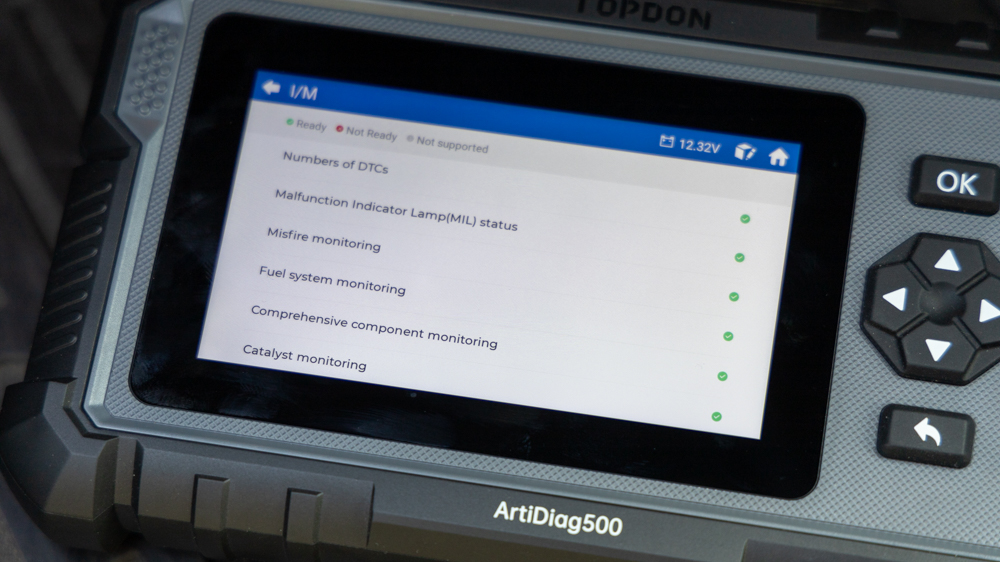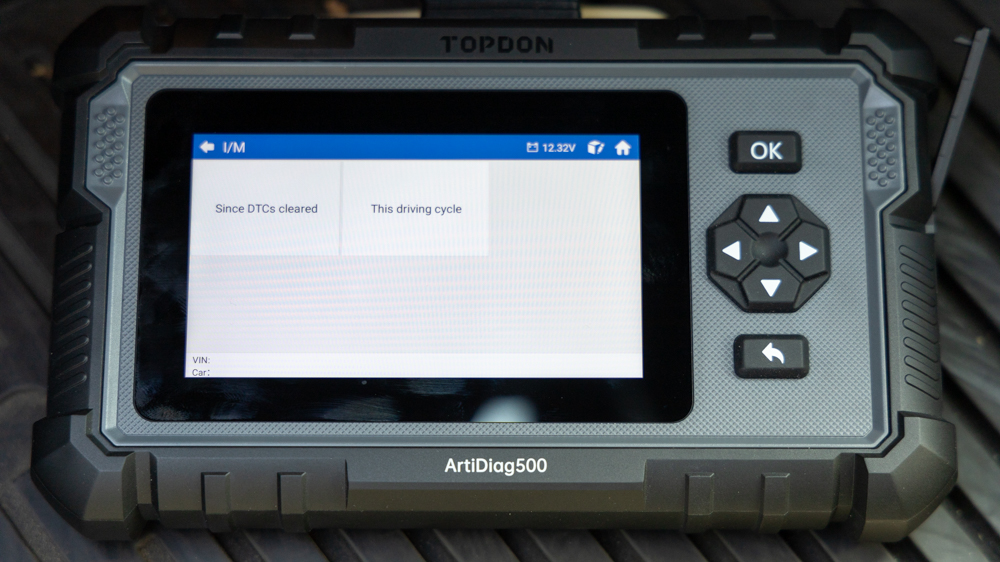Topdon ArtiDiag500 Review: Tablet OBD2 Scanner for DIYers & Project Cars
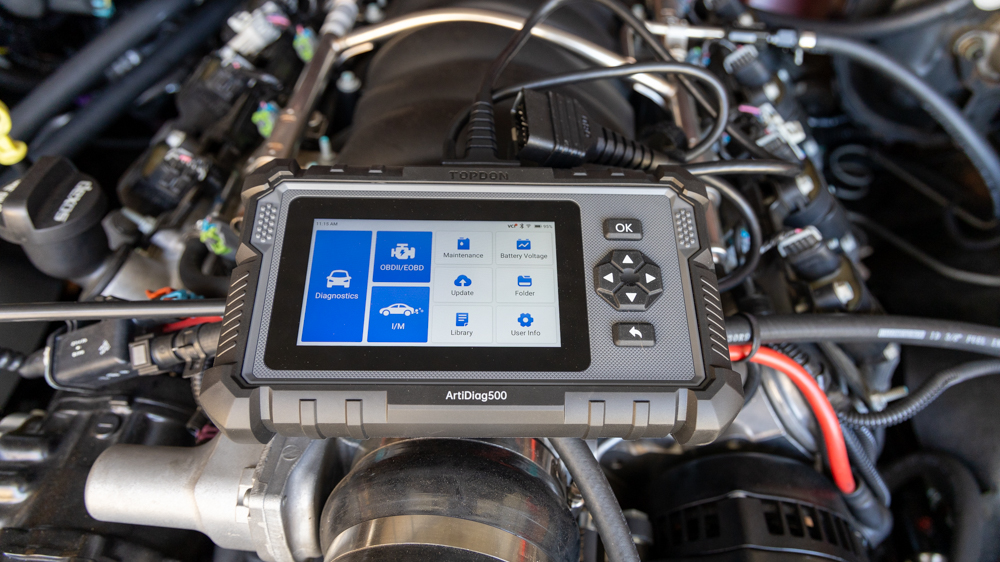
Don’t start an LS or LT engine swap without an OBD2 scanner in your toolkit. Is the Topdon ArtiDiag500 the right scanner for you?
Whether you’re working on a late-model GM vehicle or swapping an LS or LT motor into your latest project, you need an OBD2 scanner to interface with modern computer modules. The Topdon ArtiDiag500 (2024 Version) is a mid-level, tablet-style OBD2 scanner that runs on an Android operating system. In that sense, it offers more features than a basic scanner — including hot functions, Live Data, multi-module scanning, and lifetime firmware updates — but not as much functionality as more expensive, professional equipment.
Is the ArtiDiag500 right for your needs? Topdon, an LS1Tech.com sponsor, sent us one for review, and here’s everything we learned during the process.
Pricing
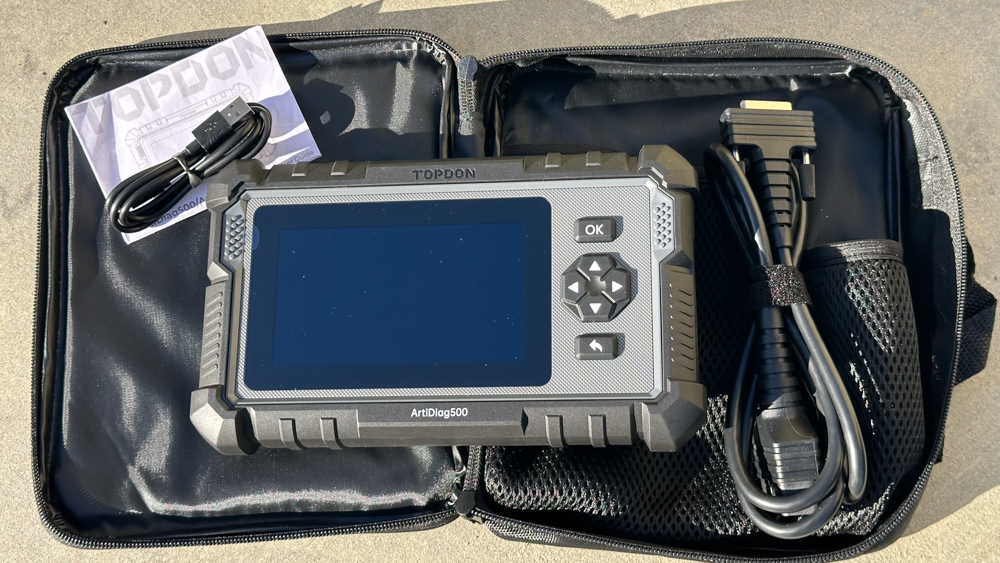
The Topdon ArtiDiag500 — the 2024 New Version — carries a $168 suggested retail price. At time of publishing, it is currently listed for sale HERE on Amazon.com for $166. In the box, you will find —
- (1) ArtiDiag500
- (1) OBD2 Cable
- (1) USB Cable
- (1) Quick User Guide
- (1) Carry Case
ArtiDiag500 Features & Specs
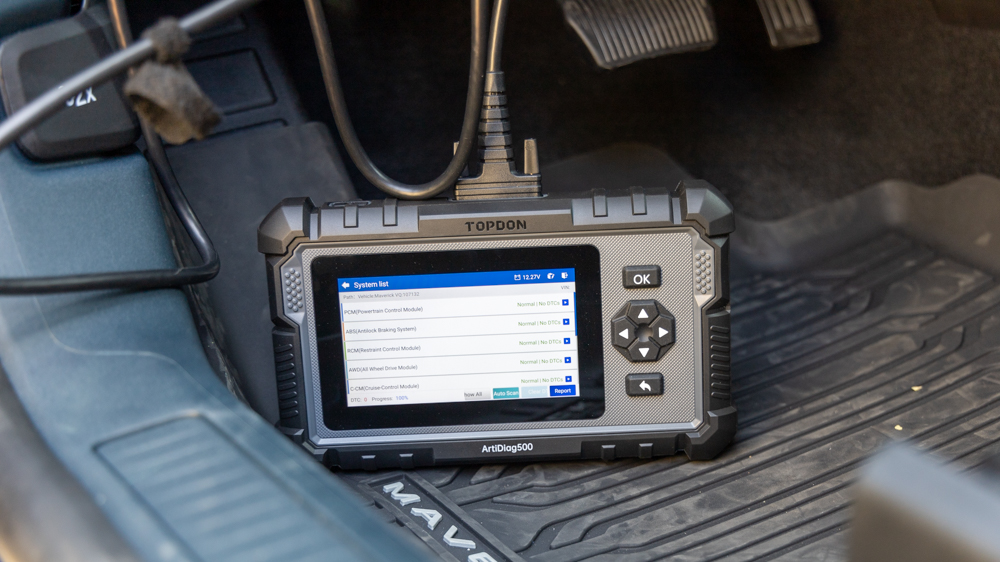
Courtesy of Topdon.com…
- Scans the four most common vehicle systems: engine, transmission, ABS, and SRS modules
- 6 reset functions (Oil Reset, Throttle Adaptation, and SAS/TPMS/BMS/EPB Reset)
- Comprehensive emission self-check
- AutoVIN
- Live Data (compare up to 4 data streams at the same time)
- Record your historical diagnostic records for replay or send your diagnostic report for printing via email.
- CPU: 4-Core 1.5GHz
- RAM: 2G
- ROM: 32G
- Battery: 3350mAh
- OS: Android 11.0
- Screen Resolution: 1280×720
- Working Temperature: 0℃~50℃(32℉~122℉)
- Language: English, French, German, Spanish, Portuguese, Russian, Japanese, Italian, Simplified/Traditional Chinese, Korea, Polish, Turkish
- 30-day money-back guarantee
- 1-year warranty
- Free Wi-Fi updates for life
Setup

If you have any questions or technical concerns, click HERE to access Topdon support where you can download an ArtiDiag500 product profile, user manual, and quick guide.
Setting up the ArtiDiag500 is simple and intuitive.
- Turn it on
- Select a language
- Set a time
- Select a WiFi network
- Log into your account (or register if needed)
- At this point, the ArtiDiag500 will check for system and firmware updates.
To connect the ArtiDiag500 to your vehicle, find the Data Link Connector (DLC), aka OBD2 port. It’s typically tucked under the dash on the driver’s side. Can’t find yours? No problem, use the DLC Location feature under Library. Once connected, turn the vehicle key (or push button start) to the ON position. But don’t start the vehicle just yet. Here it will attempt to AutoScan your VIN. If this doesn’t work, enter the VIN manually. Or you can enter the make/model/year/engine/transmission of your vehicle.

Like a traditional scan tool, the ArtiDiag500 can run off vehicle power via the DLC/OBD2 port. But it also has a built-in, USB-rechargeable battery to keep working when disconnected.
It’s worth noting that Topdon’s vehicle databases don’t go all the way to the current model year (2024+). From what I can see, there is a roughly two-to-three-year lag before the latest models appear, which is common amongst code scanners. Why? Newer vehicles 1) tend to have fewer problems, and 2), since they’re covered under new vehicle warranties, end up at dealerships that own proprietary tools and software.
You can still connect the ArtiDiag500 to current model year vehicles, mind you, for basic scans. But you might not have the same functionality and features as you would with something that’s from 2021-2022, or older.
Diagnostics

This is where you’ll do the bulk of your scanning and interacting with vehicles. The ArtiDiag500 is capable of scanning engine, transmission, ABS (anti-lock braking system), and SRS (airbag system) modules. Here, it scans for DTCs (Diagnostic Trouble Codes), which will tell you if there are any historical, pending, or current faults being monitored by the computer modules in your vehicle. This is actually the perfect amount of scanning capability for a project car, as one typically only needs to scan engine and transmission computers along with, in some states, emissions equipment.
Choices in this section include —
- Auto Scan — it will scan every module it can see, per the above
- Control Unit — you can individually scan each module
- Hot Functions — Same as the Maintenance section (see below), here you can reset the oil light, throttle adaptation, electronic parking brake, steering angle, battery management systems, and tire pressure monitoring system (if equipped)
- Vehicle Profile — shows the make, model, year, and VIN of your vehicle
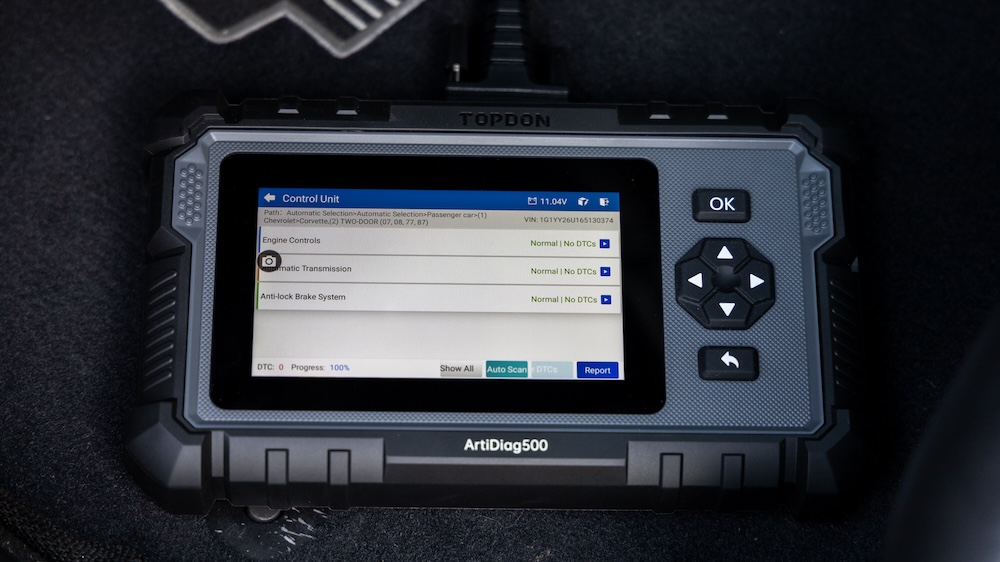
In addition to listing the trouble codes, the ArtiDiag500 offers common causes for potential codes, which can be helpful or daunting depending on how much experience you have in diagnostics. Remember, proper diagnostic methods, even if you have to pay someone, are cheaper than randomly firing the parts canon when the codes are vague enough to have several potential causes.
On Board Diagnostics 2 is the standard all 1996 and newer vehicles use to self-diagnose problems with emissions, drivetrain, and all other connected components. This standard is why one device can scan so many makes and models. In this section, you can —
- Look for trouble codes (again)
- Access Live Data
- Check the I/M readiness of the vehicle (more on this below)
- See the status of the vehicle’s onboard monitors
- Test supported components
- And see vehicle information
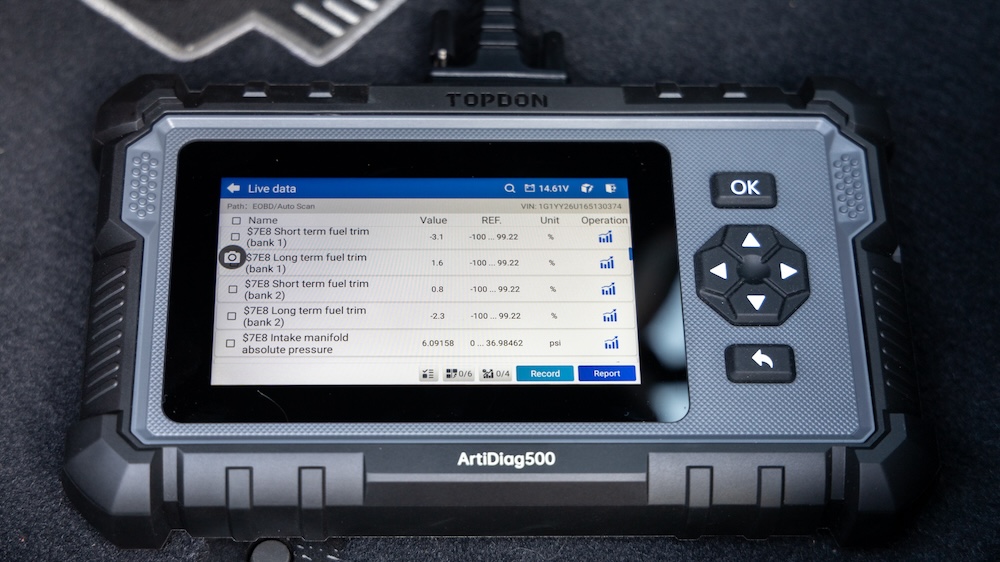
Live Data is exactly what it sounds like. If a sensor/computer is monitoring a piece of data while the vehicle is running, that’s Live Data. How fast is the engine turning? What are the O2 sensors seeing? Is the catalyst catalyzing? Are you pressing the brakes? How much are you turning the steering wheel? What’s the engine coolant temperature? And so on.
Mechanics use Live Data to look for components operating unusually and out of spec that might give them more clues to diagnose a trouble code or a poorly running vehicle. On the ArtiDiag500, users can see/record up to four simultaneous data streams. Overall, it’s a great feature to have.
I/M Readiness
The “I/M” in I/M Readiness stands for inspection and maintenance monitors. Which mostly refers to emissions testing. Basically, when OBD2 was established for the 1996 model year, vehicles needed to be able to perform their own emissions testing. If any of these monitors are 1) not active or 2) not meeting the required specifications, you won’t pass an emissions test.
By tapping the I/M Readiness button, you can see if your vehicle will pass an emissions test. The ArtiDiag500 allows you to see the I/M monitors status 1) since DTCs were last cleared or 2) this current driving cycle. From a user experience, it’s nice to have access to extra data about the I/M monitors. But most scanners offer clearer results in the form of pass/fail results (or a red, yellow, or red light). This section might confuse less experienced users.
Maintenance

In the Maintenance section, users can perform the following six functions (if the vehicle is equipped) —
- Oil Reset
- Throttle Adaptation Reset
- EPB (Electronic Parking Brake) Reset
- Steering Angle Reset
- BMS (Battery Management System) Reset
- TPMS (Tire Pressure Monitor System) Reset
Update

The Update menu lists the device’s current firmware version. Each make has its own software package, as does the tablet itself. You can perform updates here or in the User Info menu.
Library

In the library section, the ArtiDiag offers the following
- The DTC Repair Guide allows users to search for common trouble codes and see common repairs.
- The TSB library lists “Technical Service Bulletins,” which are common fixes for specific flaws identified by the vehicle manufacturer’s engineers. Unfortunately, after checking a few vehicle makes and models, this library is woefully incomplete. I wouldn’t use it.
- The DLC Location library shows picture locations for a variety of vehicle DLC/OBD2 ports. This library seemed very accurate in our searches.
- The Warning Light Library is a useful collection of warning lights that appear on vehicle gauge clusters and what they mean.
Battery Voltage

In Battery Voltage, users can look for battery voltage variances over time, which can be helpful when adding and testing accessories to get a better overall sense of the electrical system’s health, capabilities, and functionality.
Folder

In Folder, the ArtiDiag500 collects vehicle reports, recorded data streams, screenshots, and screen recordings. You can also use the Quick Support feature to remotely connect to and control the ArtiDiag500 to help solve technical issues and, when connected to Wi-Fi, surf the web on Google Chrome.
User Info

Under User Info, users will find the ArtiDiag500’s serial number along with access to settings, firmware and system updates, customer feedback options, and the ability to enter the name of their shop.
Topdon ArtiDiag500 First Impressions
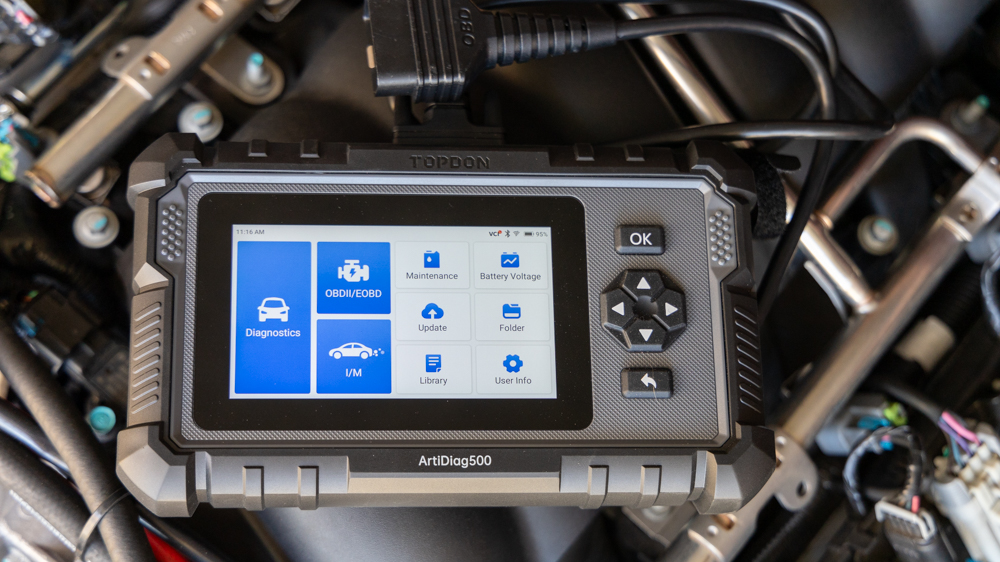
Pros
- More modern interface compared to traditional scanners
- Live Data
- Lifetime free upgrades
- Built-in battery
Cons
- Doesn’t do a full vehicle scan (like the Topdon Topscan)
- Incomplete TSB info
- Inexperienced users may be overwhelmed by too many features/terms
The ArtiDiag500 (2024 version) is an interesting device. On one hand, it delivers a high-end, tablet-style interface that’s easier to use than traditional scanners, a built-in battery, Wi-Fi and internet access, lifetime updates with no subscription fee, and the ability to document reports and record Live Data. In short, it’s (mostly) easy to use and offers a lot of value for the money for beginners and DIYers.

In my testing, the ArtiDiag500 alerted me to an issue where the LS3 in my swapped Roadmaster wagon was running lean enough to cause a trouble code. But not lean enough to throw a Check Engine light. Which is a perfect example for why every DIYer needs an OBD2 scanner.
However, on the other hand, the ArtiDiag500 feels like it’s missing some features. Case in point, it can only scan four systems. But the Topdon TopScan — both the Lite and the Pro — offers full system scanning along with more reset controls, and bi-directional controls. Granted, those are both subscription-based systems that require the owner to also have a smartphone handy. But I guess my point is that, if you’re looking to spend $170 on a scan tool, it might be worth looking at ones with more functionality like the TopScan or the ArtiDiag600.

We also noted some minor build quality issues — a screw that liked to cross-thread at the top of the tablet — and some incomplete libraries. (The TSB database was not great on the models we checked.) And it seems like more inexperienced users — those stepping up to a mid-range DIY tool for the first time — may find some of the features confusing.
That said, for DIYers or anyone doing an engine swap — a situation where you need an easy-to-use scanner for only the most common vehicle modules/systems — the Topdon ArtiDiag500 hits a sweet spot of pricing, form, and functionality. Recommended.
Click HERE to purchase the ArtiDiag500 (2024 Version) on Amazon!
or


